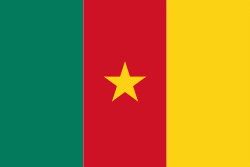Flag of Cameroon
The national flag of Cameroon (drapeau du Cameroun) was adopted in its present form on 20 May 1975 after Cameroon became a unitary state. It is a vertical tricolour of green, red and yellow, with a five-pointed star in its center. There is a wide variation in the size of the central star, although it is always contained within the inside stripe.
The colour scheme uses the traditional Pan-African colours (Cameroon was the second state to adopt them). The centre stripe is thought to stand for unity: red is the colour of unity, and the star is referred to as "the star of unity". The yellow stands for the sun, and also the savannas in the northern part of the country, while the green is for the forests in the southern part of Cameroon.
The previous flag of Cameroon, used from 1961 to 1975, had a similar colour scheme, but with two gold (darker than the third stripe by comparison) stars in the upper half of the green. It was adopted after British Southern Cameroons joined the state of Cameroon.
The original flag, made law by Law No. 46 of 26 October 1957, was the simple tricolour. It was confirmed on 21 February 1960 in the new constitution.
The colour scheme uses the traditional Pan-African colours (Cameroon was the second state to adopt them). The centre stripe is thought to stand for unity: red is the colour of unity, and the star is referred to as "the star of unity". The yellow stands for the sun, and also the savannas in the northern part of the country, while the green is for the forests in the southern part of Cameroon.
The previous flag of Cameroon, used from 1961 to 1975, had a similar colour scheme, but with two gold (darker than the third stripe by comparison) stars in the upper half of the green. It was adopted after British Southern Cameroons joined the state of Cameroon.
The original flag, made law by Law No. 46 of 26 October 1957, was the simple tricolour. It was confirmed on 21 February 1960 in the new constitution.
National flag
Country - Cameroon
Warning: getimagesize(/Image/Map/MP2233387.gif): failed to open stream: No such file or directory in /home/mapnlee7/public_html/MAPNALL/article.php on line 532
 |
 |
Early inhabitants of the territory included the Sao civilisation around Lake Chad, and the Baka hunter-gatherers in the southeastern rainforest. Portuguese explorers reached the coast in the 15th century and named the area Rio dos Camarões (Shrimp River), which became Cameroon in English. Fulani soldiers founded the Adamawa Emirate in the north in the 19th century, and various ethnic groups of the west and northwest established powerful chiefdoms and fondoms. Cameroon became a German colony in 1884 known as Kamerun. After World War I, it was divided between France and the United Kingdom as League of Nations mandates. The Union des Populations du Cameroun (UPC) political party advocated independence, but was outlawed by France in the 1950s, leading to the national liberation insurgency fought between French and UPC militant forces until early 1971. In 1960, the French-administered part of Cameroon became independent, as the Republic of Cameroun, under President Ahmadou Ahidjo. The southern part of British Cameroons federated with it in 1961 to form the Federal Republic of Cameroon. The federation was abandoned in 1972. The country was renamed the United Republic of Cameroon in 1972 and back to the Republic of Cameroon in 1984 by a presidential decree by president Paul Biya. Paul Biya, the incumbent president, has led the country since 1982 following Ahidjo's resignation; he previously held office as prime minister from 1975 on. Cameroon is governed as a Unitary Presidential Republic.
